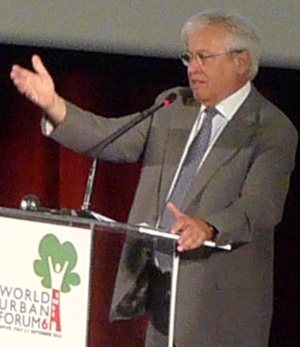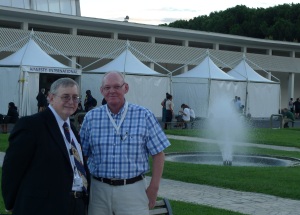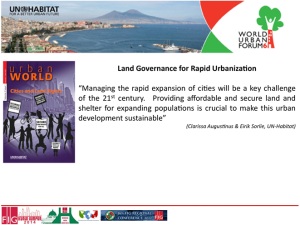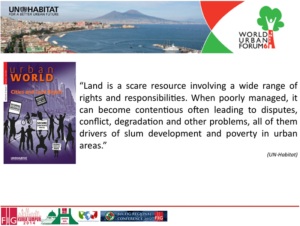Sixth World Urban Forum
Naples, Italy, 2 – 7 September 2012
Naples, the capital of the Campania Region in Italy, hosted the 6th World
Urban Forum with the theme “the urban future” from 2nd to 7th September
2012. It was reported that a total of 8,271 participants from 152 countries
attended this biennial event. Participants came from all segments of society
including national, regional and local government, parliamentarians,
multilateral organizations, civil society organizations, academia and
research organizations, private sectors and United Nations agencies.
Some of the personalities from within the FIG community that was seen at
the Forum included Honorary President Prof. Stig Enemark (Denmark);
FIG Foundation President John Hohol (United States); FIG Young
Surveyors Network Chair Kate Fairlie (Australia) and Secretary
Eva-Maria Unger (Austria); FIG Task Force for Africa Chair Dr. Diane
Dumashie (United Kingdom); University of Twente’s Prof. Jaap
Zevenbergen (The Netherlands); FIG’s incoming Vice President Bruno
Razza (Italy) and Commission 3 Chair-elect Enrico Rispoli
(Italy); Italy’s Consiglio Nazionale Geometri e Geometri Laureti President
Fausto Savoldi and International Director Maria Scorza as well as
United Kingdom’s Royal Institution of Chartered Surveyor’s Senior Vice
President Louise Brooke-Smith and John Tracey White.
|

Dr. Joan Clos, Executive Director of UN-Habitat. |

John Hohol [L] FIG Foundation President &
Stig Enemark [R] FIG Honorary President. |
The Forum was held in the context where some fifty percent of the world’s
population are currently living in urban areas often in inequitable
condition. This urban population is projected to increase to sixty percent
of all humanity by 2030. There is also the growing urban young, estimated to
increase to sixty percent of all urban dwellers by 2030. Hence at this sixth
session, the focus were on urban planning: institutions and regulations,
including the improvement of quality of life; equity and prosperity:
distribution of wealth and opportunities; productive cities: competitive and
innovative cities; and urban mobility, energy & environment. In his opening
speech, UN-Habitat Executive Director Dr. Joan Clos said the Forum
provided UN-HABITAT with the perfect chance to listen to what the
stakeholders had to say and that it is the responsibility of his agency to
relay to governments what the participants wanted done.
FIG Young Surveyors Network’s
Kate Fairlie
&
Eva-Maria
FIG Young Surveyors Network through Kate Fairlie and
Eva-Maria
Unger actively participated in the Forum, in particular, the Youth
Assembly as well as the roundtable on Youth confirming that the younger and
the youth have relationships with land. Both participated and assisted in
the drafting of the WUF6 Youth Statement and the help to feature the Social
Tenure Domain Model (STDM) within the Youth Statement. In this regard, the
younger and the youth amongst our surveying fraternity has a role in
communicating, piloting and up-scaling the Social Tenure Domain Model
towards securing land and property rights for all.
Uganda showcased a new land record system at this Forum designed to
ensure that land rights of the poor are enshrined and respected in towns and
cities across the country. HE Daudi Migereko, Minister of Land,
Housing and Urban Development of Uganda explained how the country had used
the STDM in capturing and registering the relationship to land of informal
settlers in Mbale. The FIG Foundation also supported this pilot project in
the Ugandan southwestern town of Mbale led by the Global Land Tool Network
of UN-Habitat. (The Foundation made a token financial and technical
contribution where FIG Platinum Corporate Member, Trimble Navigation,
provided the GNSS/mapping technology and access to technical support through
the Foundation).
At the Global Land Tool Network Roundtable with the theme
“Celebrating the Recognition of a Range of Land Rights: Taking Stock and
Moving Forward”, FIG President CheeHai TEO said that the Continuum of
Land Rights has provided an “initial point of entry” for many jurisdictions
and allowed many more to begin the journey towards secure tenure rights for
all. These are reasons enough to celebrate. He opined that as the quest for
secure tenure rights for all continues, GLTN should look beyond rights. With
secure tenure rights, there will be responsibilities. Hence there would be a
series of continuum within this continuum of land rights.
FIG President observed that the Profession has the competence to
contribute significantly, is contributing and has the courage to take upon
this complex technical component in this “Continuum”. Hence the Profession
should not complicate further that which is already complex, rather to
contribute in the development and implementation of more “fit-for-purpose”
approaches, taking into consideration context, scale and opportunity. He
opined that the Profession must remain resolute in this contribution.
|
 |
Lantmateriet of Sweden, an Affiliate Member of FIG had a “Networking
Session” within the Forum and had invited FIG President CheeHai Teo to make
a presentation. The session was titled “Land Administration and Sustainable
Economic Development” and in his presentation, the FIG President reiterated
that land administration and management must be intentional and now
generational. It needs sound land policies, good and trusted land
information, together with efficient and collaborating institutions,
effective land administration and management leads to informed decisions
that will address the challenges of sustainable access to land, secure
tenure rights, adequate shelter, infrastructure, basic services and thus
sustainable development. Land administration is about people to land
relationship and must be sensitive to the disadvantaged. Going forward, it
needs to consider the succeeding generation that has hopes and aspirations,
that has at times demonstrated and demanded, a segment in society who are in
touch with current realities. Given the current challenges and scenarios,
bold and creative approaches are necessary and land administration and
management is not spared this need for boldness and innovativeness.
|
 |
Some of the key messages that came out of the sixth session of the World
Urban Forum include:
- To attain sustainability, it is essential to strengthen
participatory approaches to assure inclusive ownership of the urban
development process;
- Legal and regulatory frameworks aimed at giving access to land for
the urban poor should be based on clear understanding of how urban land
markets work;
- The need to recognize the strong positive link between urbanization
and development;
- Urgent attention be given to the urban economy especially job
creation with deliberate effort to empower women and youth initiatives
in designing job creation proposals at all times; and
- A call for a new approach in providing adequate and affordable
housing.
At the closing ceremony, it was announced that the city of Medellin in
Columbia would host the seventh session of the World Urban Forum in 2014.
CheeHai TEO
September 2012
5 October 2012
|

